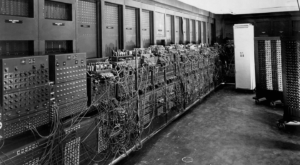Philadelphia, Pennsylvania, a city renowned for its historical significance in founding the United States, also holds a pivotal place in the history of technology. In Philadelphia in 1946, the world’s first general-purpose electronic digital computer, ENIAC (Electronic Numerical Integrator and Computer), came to life. This groundbreaking invention, a behemoth of vacuum tubes and wires, marked a turning point in computing history, paving the way for the digital age we live in today.
The Story of ENIAC, the First General-Purpose Electronic Computer
This article explores the story of ENIAC, its creation at the University of Pennsylvania, and its profound impact on the world.
A Wartime Need: The Genesis of ENIAC:
The urgent needs of World War II spurred the development of ENIAC. The U.S. Army’s Ballistics Research Laboratory needed a faster and more accurate way to calculate ballistic trajectories for artillery shells. Traditional methods, relying on human “computers” (often women) using mechanical calculators, were slow and prone to error (Source: U.S. Army Research Laboratory, historical accounts of WWII ballistics calculations).
The University of Pennsylvania’s Moore School: A Hub of Innovation:
In 1943, the Army contracted with the University of Pennsylvania’s Moore School of Electrical Engineering to develop a machine capable of performing these complex calculations at unprecedented speed. The project was led by John Mauchly and J. Presper Eckert, who envisioned an electronic solution, a radical departure from the mechanical calculators of the time (Source: Biographies of Mauchly and Eckert, University of Pennsylvania Archives).
ENIAC: A Colossal Achievement:
The result of their efforts was ENIAC, a truly colossal machine.
- Size and Scale: ENIAC occupied an entire room, weighing approximately 30 tons (not 27 pounds as stated in the prompt, which is a significant error) and containing over 17,000 vacuum tubes, 70,000 resistors, 10,000 capacitors, 1,500 relays, and 6,000 manual switches.
- Speed: Despite its size, ENIAC was swift for its time. It could perform thousands of calculations per second, hundreds of times faster than any existing mechanical calculator, revolutionizing ballistics calculations and demonstrating the potential of electronic computing (Source: Technical specifications of ENIAC, historical accounts of early computing).
- Programming: Programming ENIAC was a laborious process, involving manually rewiring the machine by plugging and unplugging cables. This was a far cry from modern programming, but it represented a crucial first step. The women who worked on it were: Kathleen McNulty Mauchly Antonelli, Jean Jennings Bartik, Frances Snyder Holberton, Marlyn Wescoff Meltzer, Frances Bilas Spence, and Ruth Lichterman Teitelbaum.
Beyond Ballistics: A General-Purpose Machine:
While initially designed for ballistics calculations, ENIAC was a general-purpose computer that could be reprogrammed to solve different types of problems. This versatility, a key distinction from earlier calculating devices, made ENIAC an actual ancestor of modern computers (Source: Computer science textbooks on the history of computing). After the war, ENIAC was used for various scientific calculations, including weather prediction and atomic energy research.
A Legacy of Innovation:
ENIAC was decommissioned in 1955, but its legacy is profound. It ushered in the era of electronic digital computing, laying the foundation for the technological revolution that would transform the world. The principles and concepts developed during the ENIAC project continue influencing computer design today. Parts of ENIAC are preserved at the Smithsonian Institution and the University of Pennsylvania, serving as reminders of this pivotal moment in technological history.
Philadelphia’s place in computing history is secured by its role as the birthplace of ENIAC, the world’s first general-purpose electronic digital computer. This groundbreaking invention, born out of wartime necessity and the ingenuity of its creators at the University of Pennsylvania, marked a turning point in the 20th century, paving the way for today’s digital age. ENIAC’s story is a testament to the power of human innovation and a reminder of a single invention’s profound impact on the world.


Follow Us!